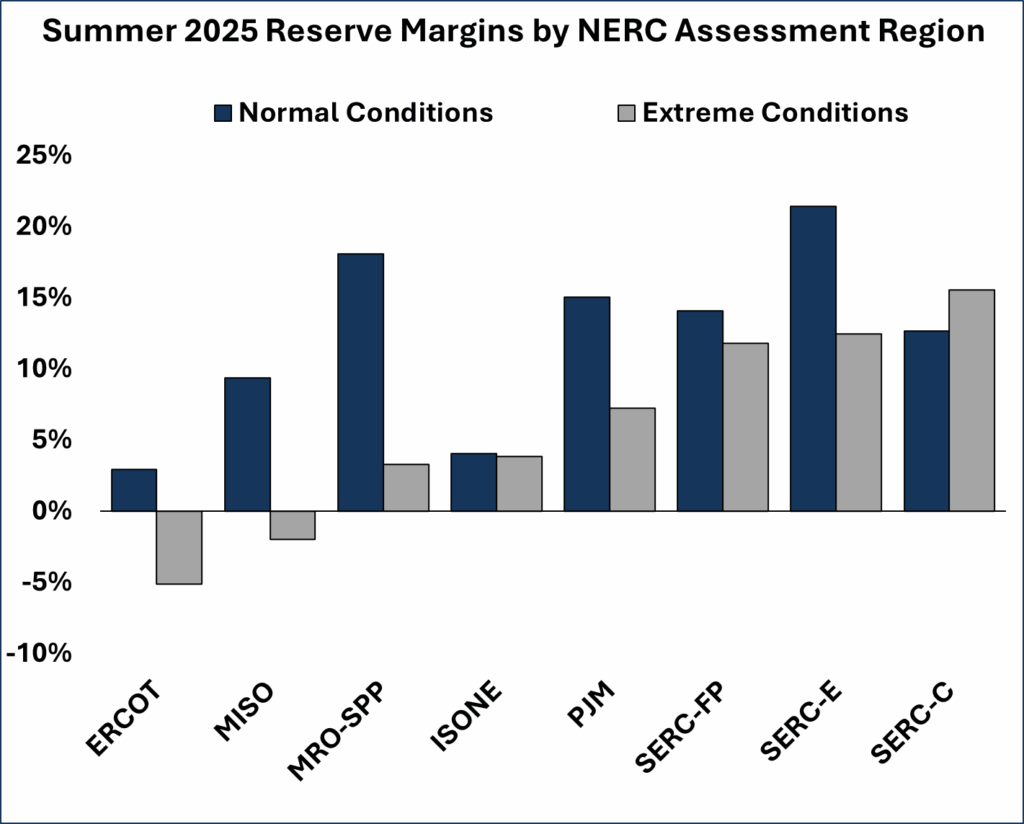HEADLINE: “NERC’S 2025 SUMMER RELIABILITY REPORT WARNS OF TIGHT MARGINS AS COAL FLEET CONTINUES TO SHRINK”, By Michelle Bloodworth
“Last month, the North American Electric Reliability Corporation (NERC) published its 2025 Summer Reliability Assessment, revealing a growing challenge for U.S. grid operators: electricity demand…”
NERC’S 2025 SUMMER RELIABILITY REPORT WARNS OF TIGHT MARGINS AS COAL FLEET CONTINUES TO SHRINK
Last month, the North American Electric Reliability Corporation (NERC) published its 2025 Summer Reliability Assessment, revealing a growing challenge for U.S. grid operators: electricity demand is rising faster than dispatchable resources are being added, even as numerous coal-fired power plants have announced plans to retire. NERC projects that peak demand across its U.S. assessment areas will exceed last summer’s levels by more than 10 gigawatts (GW), while 7.4 GW of conventional generation—including 2.1 GW of coal capacity—has already retired in advance of the 2025 peak heat season. Although solar and battery installations are surging, NERC cautions that these variable or energy-limited resources do not consistently meet demand when levels remain high during the evening hours.The first figure below provides a visual reminder of the trend, showing that more than 50 GW of additional coal capacity is still scheduled to retire by the end of the decade. The second illustrates how slim many regional safety cushions become once extreme weather, low wind output, or higher-than-normal unit outages are layered onto the forecast.
Regions Facing the Greatest Strain
Midcontinent ISO (MISO) enters the summer with 1,575 MW of coal and gas retirements since last year, along with a reserve margin that turns negative under extreme conditions. This situation has led NERC to classify the region as at “elevated risk” for potential power outages. The system’s greatest vulnerability currently occurs in August, when solar output diminishes earlier in the evening, while demand remains high. ERCOT (Texas) will begin the season with record-high solar and nearly double the battery storage capacity it had a year ago. However, NERC warns that evening hours remain risky once the sun sets, especially if wind production declines or conventional units go offline unexpectedly. Probability studies still indicate that the chance of an Energy Emergency Alert during the highest-risk hour is roughly 3 percent—lower than in 2024, but not zero. SERC Central saw its reserves increase last summer; however, upcoming coal closures will diminish much of that buffer, leaving the sub-region dependent on non-firm imports if higher-than-normal heat coincides with unit outages. Southwest Power Pool (SPP) can meet demand during a typical summer but faces the risk of shortfalls if low wind output coincides with high temperatures and forced outages. ISO New England also enters the season with a narrow 4 percent extreme condition margin and expects to rely on operating procedures and imports to meet peak summer demand.
Implications for Policymakers
NERC’s assessment clearly shows that dispatchable, fuel-secure generation—particularly the existing coal fleet—continues to be essential for meeting demand during heat waves, unexpected unit outages, or renewable production lulls. Without it, several regions could face capacity deficits as early as this summer.
“Coal plants store weeks of fuel on site and can run around the clock, providing the reliability attributes regulators consistently say they need—yet these plants are disappearing faster than reliable replacements are being built,” said Michelle Bloodworth, President and CEO of America’s Power. “We urge state regulators, Members of Congress, and FERC to pause additional coal retirements until proven, dispatchable alternatives are fully in place.”
BOTTOMLINE: “Coal plants store weeks of fuel on site and can run around the clock, providing the reliability attributes regulators consistently say they need—yet these plants are disappearing faster than reliable replacements are being built,” said Michelle Bloodworth, President and CEO of America’s Power. “We urge state regulators, Members of Congress, and FERC to pause additional coal retirements until proven, dispatchable alternatives are fully in place.”






